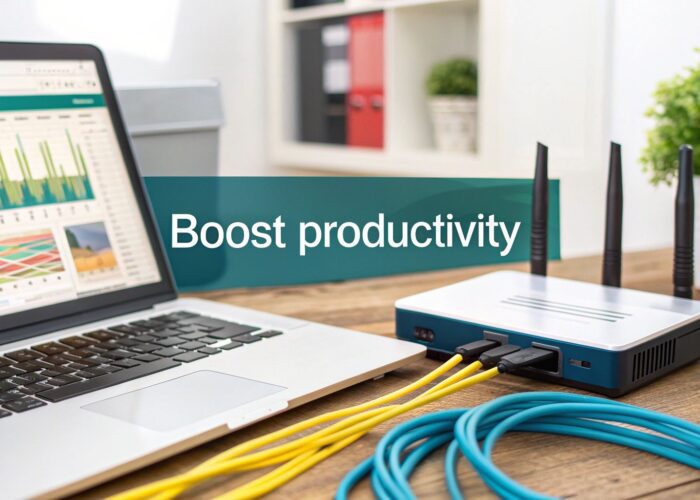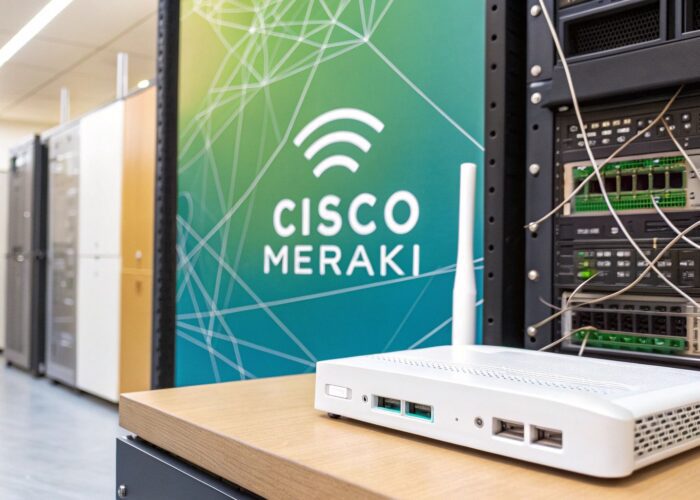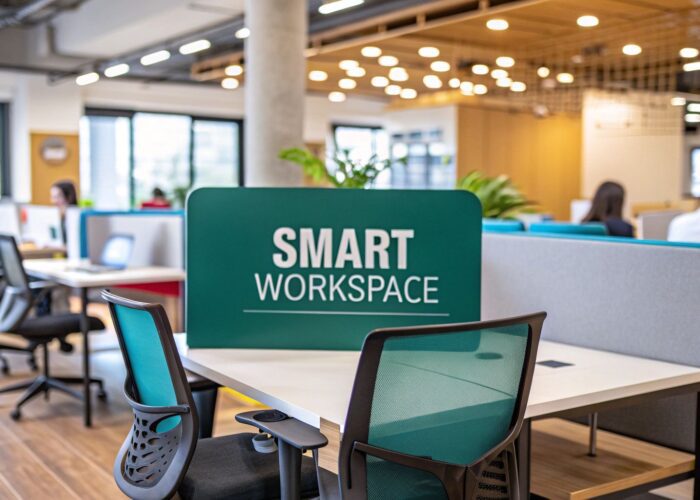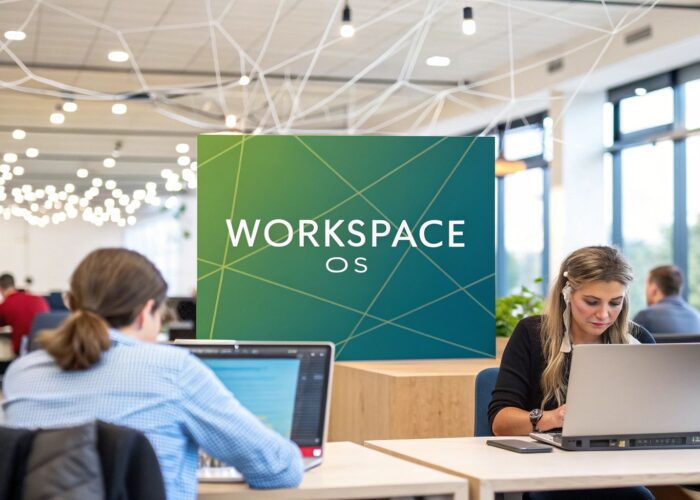Hey there! In today's super-fast world, improving staff productivity isn't just another box to tick; it's the secret sauce for staying ahead and growing your business. Whether you're running a bustling retail store, a dynamic corporate office with a "bring your own device" (BYOD) policy, or a sprawling university campus, every minute of your team's time is pure gold. The real goal isn't to push people to work harder, but to empower them to work smarter. This is where a great productivity game plan meets solid tech, and that's where the magic happens.
This guide will walk you through nine powerful, yet totally practical, strategies to get your team firing on all cylinders. We'll explore how a seamless and secure Wi-Fi network, powered by industry leaders like Cisco and Meraki, can do way more than just provide internet. When you manage it with smart Captive Portals and slick Authentication Solutions like IPSK or EasyPSK, your network becomes the backbone of a super-efficient workplace. For a bigger picture on boosting your organization's output, check out our guide on strategies to improve operational efficiency. Let's dive in and see how you can transform your team's performance!
1. Streamline Onboarding with Secure, Automated Wi-Fi
You know what they say about first impressions! A clunky, frustrating login process on a new employee's first day is a total vibe killer. A slow Wi-Fi connection is an instant productivity blocker, forcing new hires to wrestle with credentials or wait for IT to save the day. By automating secure network access, you empower your team from the get-go, which is a massive step in improving staff productivity for the long haul.
An advanced Authentication Solution completely changes this experience. Picture a new teacher in an Education setting, a new associate in Retail, or a new team member in your Corporate office connecting their personal and work devices (hello, BYOD!) instantly and securely on day one. It's not just about being convenient; it's about reclaiming precious hours that would otherwise be lost to tech headaches.
Why It Works for Modern Workplaces
This automated approach is a lifesaver in dynamic environments like Education, Retail, and BYOD-friendly Corporate offices. A university can onboard thousands of students and faculty each semester without lifting a finger. A retail chain can give temporary, secure access to seasonal staff across dozens of stores, making sure they're ready to help customers right away.
How to Implement Automated Wi-Fi Onboarding
Getting started is easier than you might think, especially if your organization is already using top-notch network gear from Cisco Meraki.
- Integrate with Your Directory: Connect your Captive Portal to existing directories like Azure AD or Google Workspace. This gives everyone a true single sign-on experience, letting them use the passwords they already know and love.
- Embrace QR Codes: For lightning-fast connections, use QR codes. A new staff member can just scan a code to get their device set up on the secure network, skipping the manual setup completely.
- Enhance BYOD Security: For places with lots of personal devices, use solutions that support IPSK (Individual Pre-Shared Key) or EasyPSK. These awesome technologies create a unique, secure Wi-Fi key for each user's devices, which is way more secure than a single shared password for everyone.
- Create a Professional Welcome: Use a solution like Splash Access to customize your Captive Portal. A branded, professional-looking login page reinforces your organization's identity and creates a seamless, friendly welcome for everyone.
2. Offer Flexible Work Arrangements
Let's be real, the rigid 9-to-5 is going out of style. Offering flexible work arrangements—like remote work, hybrid models, or different hours—is a brilliant way to show you trust your team. It acknowledges that people are most productive at different times and in different places. This freedom empowers employees, boosts morale, and is a game-changer for improving staff productivity.
When you give your team this flexibility, you're building a culture of accountability and results. Employees can find a better work-life balance, which means less burnout and more engagement. From Corporate offices embracing BYOD to Retail businesses managing staff across multiple spots, flexibility is a powerful tool for keeping your best people happy and efficient.

Why It Works for Modern Workplaces
A flexible model is perfect for jobs where results matter more than the hours clocked. A corporate team can collaborate from anywhere, while a university can let admin staff work from home, freeing up space on campus. Even Retail can benefit by offering flexible schedules to attract awesome talent. The key to making it all work? Rock-solid, secure Wi-Fi that lets everyone connect seamlessly, no matter where they are.
How to Implement Flexible Work Arrangements
Making a flexible workforce thrive is all about great tech and clear communication. For organizations using network hardware like Cisco Meraki, this is totally achievable.
- Ensure Secure Remote Access: The foundation of any flex-work policy is secure, reliable Wi-Fi from anywhere. A powerful Authentication Solution ensures that whether an employee is at home or a coffee shop, their connection to company stuff is always protected.
- Set Clear Expectations: Define your communication rules, core hours when people should be available, and clear goals. Being clear prevents confusion and keeps everyone on the same page.
- Invest in Collaboration Tools: Give your team the software they need to chat and manage projects together, like video conferencing and shared workspaces.
- Simplify Connectivity for All: Use a Captive Portal with EasyPSK or IPSK to manage network access for everyone—on-site, hybrid, and temporary staff. This gives each person a unique, secure key for their devices, making it a breeze to manage a team that's always on the move. You can see how even small businesses benefit from streamlined tech solutions to support these modern work styles.
3. Foster Alignment with Goal Setting and OKRs
Without clear, shared goals, even the best teams can start pulling in different directions, which means wasted effort and slow progress. The OKR (Objectives and Key Results) framework is a fantastic way to fix this. It creates a straight line between individual tasks and the big company vision. This method is a proven way of improving staff productivity because it gets everyone rowing in the same boat.
An OKR has an ambitious Objective (what you want to do) and a few measurable Key Results (how you'll know you're getting there). This structure, made famous by tech giants who used it to scale and innovate, turns high-level strategy into clear, actionable steps that get the whole team excited and aligned.
Why It Works for Modern Workplaces
OKRs are super effective in fast-moving places like Retail, Education, and dynamic Corporate offices. A retail chain could set an objective to "Wow Customers in Q4," with key results like cutting down checkout times or getting more positive online reviews. A university might aim to "Boost Student Engagement," measured by things like event attendance and how often students use online resources—all accessed via secure Wi-Fi, of course! It gives every single employee a clear "why" behind their daily grind.
How to Implement OKRs Effectively
You don't need fancy software to adopt OKRs, just a commitment to being clear and talking regularly.
- Set Aspirational Objectives: Objectives should be big and inspiring. Think "Become the #1 student choice for our city" instead of "Increase student applications."
- Define Measurable Key Results: Each Key Result has to be a number. Instead of "Improve our website," try "Increase website traffic from social media by 20%."
- Keep it Focused: Limit each team or person to 3-5 OKRs per quarter so nobody gets overwhelmed. It's all about focusing on what really moves the needle.
- Promote Transparency: Make OKRs visible to everyone. This builds accountability and helps teams see how their work fits into the bigger picture.
- Review and Adapt: Check in on progress regularly. OKRs aren't set in stone; they're meant to be flexible as things change.
4. Employee Recognition and Rewards Programs
Feeling appreciated is a huge motivator, and a solid recognition program is a cornerstone of improving staff productivity. When employees see their hard work get noticed, they become more engaged, creative, and committed to the company's goals. A well-thought-out rewards program turns "thank you" from a nice surprise into a core part of your culture, fueling a more productive and positive vibe.
This is about more than just a yearly bonus. It's about creating a constant feedback loop where great work is celebrated right away. Whether it's in a busy Retail store, a collaborative Corporate office, or a dynamic Education campus, recognizing achievements reinforces the behaviors you want to see and builds a culture of excellence.

Why It Works for Modern Workplaces
In today's world, feeling good about your work is key. Recognition programs are super effective in BYOD-friendly corporate settings and Retail environments where team morale directly impacts customer service. For example, a hotel can recognize a front-desk associate for amazing guest feedback, inspiring the whole team. Likewise, a university can publicly praise a department for coming up with innovative teaching methods, which fosters a great collaborative spirit.
How to Implement Recognition and Rewards
Building a great program is about more than just handing out gift cards. It needs to be thoughtful, transparent, and consistent.
- Make Recognition Timely and Specific: Acknowledge wins as they happen, not weeks later. Instead of a generic "good job," tell them exactly what they did well and the impact it had.
- Offer a Variety of Rewards: Mix it up! Combine money rewards with other cool perks like extra time off, professional development courses, or a shout-out in the company-wide newsletter.
- Celebrate Team and Individual Wins: Recognize both the solo superstars and the teams that worked together to crush a goal. This shows that both personal effort and teamwork are valued.
- Leverage Technology for Peer-to-Peer Recognition: Use your internal chat platforms to let employees give each other kudos. This helps build a positive and supportive culture from the ground up.
5. Foster Continuous Learning and Skills Development
In today's world, you can't stand still. Investing in continuous learning is a brilliant strategy for improving staff productivity because it gives your team the tools to adapt, innovate, and master new challenges. This isn't just about a yearly training session; it's about building a culture where learning is a normal, ongoing part of the job.
When you provide clear paths for growth, you empower employees to take charge of their careers, which boosts both their skills and their engagement. This leads to a more skilled, motivated, and productive workforce that's ready for anything.
Why It Works for Modern Workplaces
This is crucial in fast-changing sectors like Education, Retail, and tech-driven Corporate environments. A school district can train teachers on new digital tools, while a retail chain can get staff up to speed on the latest inventory systems. In corporate offices with a strong BYOD culture, ongoing training makes sure everyone can use their own devices securely and effectively within the company's network.
How to Implement a Learning and Development Program
Weaving a culture of learning into your daily operations is easier than you think, especially with a modern IT setup.
- Align Learning with Business Goals: Figure out what skills your company needs to win and build your training around that. Focus on things that directly support your main goals.
- Offer Diverse Learning Formats: People learn in different ways, so offer a mix of online courses, hands-on workshops, mentoring, and access to industry events.
- Leverage Technology for Training: Use your secure network to deliver training. For example, a branded Captive Portal could point staff to an internal training site as soon as they log onto the Wi-Fi.
- Automate Access to Learning Tools: Use API integrations to connect learning platforms with your employee directory. As you automate these processes, just remember that securing API keys is super important to keep everyone's data safe.
6. Automation and Technology Integration
Repetitive, manual tasks are the silent killers of productivity. They eat up valuable time that your team could be spending on more important, creative work. By embracing automation and smart tech, you can get rid of these bottlenecks, cut down on human error, and unlock your team's true potential. This is a massive step in improving staff productivity, as it frees people from boring work so they can focus on customers and innovation.
Imagine automating visitor access in a corporate office or streamlining event check-ins at a university. Instead of someone manually typing in info, integrated systems handle it all seamlessly. This isn't about replacing people; it's about giving them better tools to do more meaningful work.
The infographic below shows just how much automation can change the game.
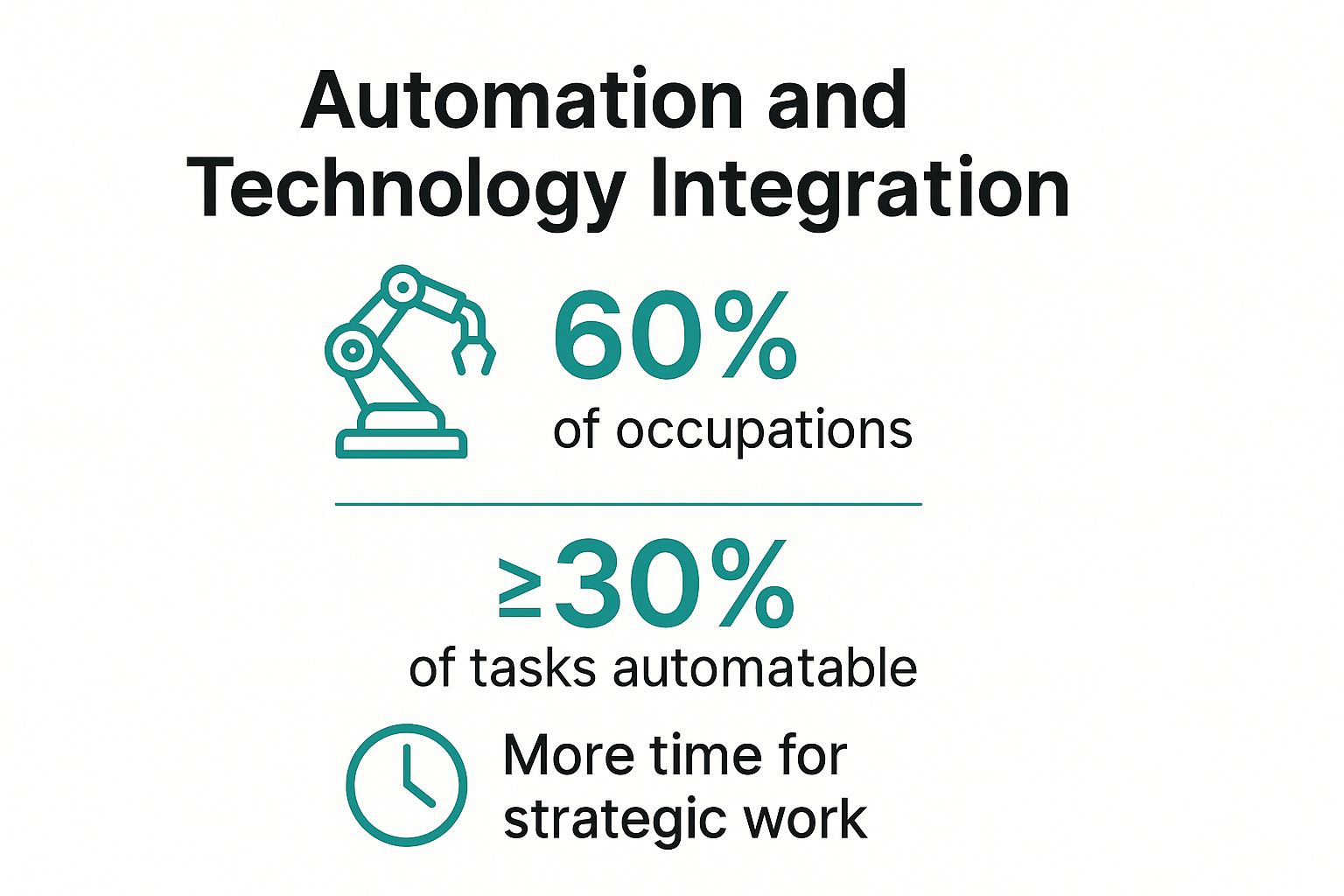
These stats show a huge opportunity for businesses to get time back and let their teams focus on more complex and creative challenges.
Why It Works for Modern Workplaces
Automation is a game-changer for dynamic places like Retail, Education, and Corporate offices with BYOD policies. A retail chain can automate inventory alerts, while a school can automate student registration. In a corporate setting using Cisco Meraki, API-driven automation can manage Wi-Fi access for temporary contractors, giving and taking away access without any IT help. Talk about a huge efficiency win!
How to Implement Automation and Technology Integration
You can start integrating automation in small, manageable steps that deliver results right away.
- Start with High-Impact Tasks: Look for the simple, repetitive jobs that take up the most time. This could be anything from running daily reports to managing guest Wi-Fi passwords.
- Involve Your Team: Ask your employees what tasks are the most tedious. They'll have the best ideas for what to automate first and will be more excited about using the new tools.
- Leverage Your Existing Infrastructure: Use the API capabilities of your network hardware, like Cisco Meraki, to build custom workflows. For instance, you can automate IT with a dashboard API to create custom triggers for network events.
- Provide Adequate Training: Make sure your team feels comfortable with the new automated systems. Good training will help everyone get on board and see how the tech makes their jobs easier.
7. Foster Clear and Effective Communication
When communication is messy, it's a huge drain on productivity. It leads to misunderstandings, people doing the same work twice, and disengaged employees. When info doesn't flow freely, people waste time hunting for answers or working on the wrong things. Setting up clear communication channels is essential for improving staff productivity because it keeps everyone on the same page, informed, and ready to go.
A culture of proactive communication can totally transform a workplace. Think of a Retail team getting instant updates on new promotions, or a Corporate office where projects run smoothly because everyone knows who to talk to. This isn't just about sending more emails; it's about getting the right info to the right people at the right time.
Why It Works for Modern Workplaces
In fast-paced environments like schools (Education), stores (Retail), or corporate offices with lots of BYOD, streamlined communication is a must. A university can send out campus-wide alerts in a flash, while a hotel can coordinate its front-desk, housekeeping, and maintenance teams without a hitch. This clarity cuts down on friction and lets people focus on their jobs instead of chasing down information.
How to Implement Effective Communication
Building a better communication system involves both tech and a shift in culture, especially in a Cisco Meraki environment.
- Establish Clear Protocols: Decide which channels to use for what. For example, a messaging app for quick updates, email for official news, and project management tools for task-specific chats.
- Leverage Unified Platforms: Try to centralize communication to reduce app-switching. Having a single source of truth makes sure important messages don't get lost.
- Automate Critical Alerts: Use technology to push important info directly to your team. For example, a Captive Portal can display key updates when people log in, or you can configure real-time alerting with webhooks to let IT know about network issues instantly.
- Encourage Two-Way Feedback: Create regular chances for staff to share their thoughts and ask questions. An open-door policy, whether it's virtual or in-person, builds trust and helps everyone improve together.
8. Workspace Optimization and Ergonomics
An employee's physical and digital space has a huge impact on their focus, well-being, and output. A poorly designed workspace—with bad lighting, uncomfortable chairs, or constant noise—is a major roadblock to improving staff productivity. Optimizing the workspace isn't a luxury; it's a core strategy for helping your team do their best work.
A well-designed environment reduces physical strain and mental burnout, letting employees really concentrate. From adjustable desks in a corporate office to quiet zones in a busy university library, thoughtful design makes a world of difference. This focus on comfort shows you care about your team's health and performance.
Why It Works for Modern Workplaces
This is super important in any setting where concentration and comfort matter. Tech companies and modern Corporate offices have been fans of ergonomic setups for years to help their teams focus. Likewise, Education institutions are redesigning libraries and common areas to support different study styles, while co-working spaces have built their entire business model on providing awesome, flexible work environments.
How to Implement Workspace Optimization
Creating a more productive physical space can be done with a few smart, often simple, tweaks.
- Conduct Ergonomic Assessments: Regularly check in on employee workstations to fix any issues with posture, screen height, or chair support.
- Provide Adjustable Equipment: Invest in adjustable chairs, standing desks, and monitor arms. Letting people customize their setup for maximum comfort is key to reducing strain.
- Create Diverse Work Zones: Set up different areas for different kinds of work: quiet zones for deep focus, collaborative spaces for team meetings, and comfy spots for breaks. This is a core feature of successful co-working and flexible office spaces.
- Manage Light and Noise: Maximize natural light and provide good task lighting. Use noise-dampening materials or offer noise-canceling headphones to cut down on distractions in open offices or busy Retail backrooms.
9. Time Management and Prioritization Techniques
Working without focus is a huge waste of resources, but teaching your team proven time management tricks can completely change their output. These systematic approaches help employees tell the difference between "busy work" and high-impact tasks, which is a key skill for improving staff productivity. Instead of guessing what to do next, these techniques give them a clear plan.
Using methods like the Eisenhower Matrix helps staff sort tasks by what's urgent and what's important. This makes sure that big, long-term goals don't get pushed aside by small, immediate requests. In a busy Retail environment or a Corporate office with constant pings, this structure is a lifesaver for staying focused and reducing stress.
Why It Works for Modern Workplaces
These techniques work so well because they create a common language for productivity. A school administrator in Education can use time blocking to set aside specific hours for budget planning without being interrupted. Similarly, a Corporate team can use a shared system to align their efforts on a major project, ensuring everyone is focused on what truly matters.
How to Implement Time Management Techniques
You can introduce these frameworks gradually to help your team build lasting habits.
- Start with the Eisenhower Matrix: Encourage staff to sort their daily tasks into four boxes: Urgent/Important (Do now), Important/Not Urgent (Schedule it), Urgent/Not Important (Delegate it), and Not Urgent/Not Important (Delete it).
- Introduce Time Blocking: Teach employees to schedule their whole day in blocks, assigning specific tasks to each chunk of time. This cuts down on multitasking and encourages deep, focused work.
- Batch Similar Tasks: Group similar activities together, like answering all emails at once or making all your calls in another block. This reduces the mental effort of switching between different kinds of work.
- Protect Deep Work Time: While tools like a Captive Portal can make getting online a breeze, it's just as important to protect focus. Encourage "do not disturb" periods where staff can tackle complex tasks without interruption.
9 Strategies for Boosting Staff Productivity
| Item | 🔄 Implementation Complexity | 💡 Resource Requirements | 📊 Expected Outcomes | ⭐ Key Advantages | ⚡ Ideal Use Cases |
|---|---|---|---|---|---|
| The Pomodoro Technique | Low – Simple timer-based system | Minimal – Timer and discipline | Moderate – Improved focus, reduced fatigue | Easy to adopt, boosts concentration | Short tasks, study sessions, combating procrastination |
| Flexible Work Arrangements | Medium – Requires policies & tools | Medium to High – Technology and management | High – Increased satisfaction, reduced commute | Enhances work-life balance, talent access | Remote/hybrid teams, diverse workforce |
| Goal Setting and OKRs | Medium – Structured goal framework | Medium – Management commitment | High – Clear alignment, measurable progress | Drives focus, transparency, ambitious goals | Organizations needing goal alignment |
| Employee Recognition & Rewards | Medium – Needs consistent implementation | Medium – Reward programs & platforms | High – Higher engagement, retention | Motivates employees, builds culture | Teams needing morale boost and retention |
| Continuous Learning & Skills Dev | High – Ongoing training ecosystem | High – Training, platforms, mentorship | High – Skill growth, retention, promotion | Builds capabilities, aligns with business | Organizations focused on growth & retention |
| Automation & Technology Integration | High – Technically complex | High – IT resources, ongoing maintenance | Very High – Efficiency, error reduction | Saves time, improves accuracy | Processes with repetitive tasks, digital transformation |
| Effective Communication Strategies | Medium – Policy & culture changes | Medium – Tools and training | High – Better collaboration, decision speed | Reduces errors, increases engagement | Teams needing collaboration & transparency |
| Workspace Optimization & Ergonomics | Medium – Design and equipment needs | Medium to High – Furniture, layout, maintenance | Moderate – Comfort, reduced injury | Improves well-being, focus, creativity | Physical and hybrid office environments |
| Time Management & Prioritization | Low to Medium – Framework adoption | Minimal – Tools and training | Moderate to High – Better focus, less stress | Enhances task completion, decision-making | Individual productivity, knowledge workers |
Putting It All Together: Your Blueprint for Productivity
Improving staff productivity isn't about finding one magic trick. As we've seen, true efficiency is a mix of smart policies, a supportive culture, and awesome technology that creates an environment where your team can really shine.
All these strategies—from optimizing workspaces to setting clear goals—are connected. A flexible work plan is only as good as the tech that supports it. A recognition program is more meaningful when it's tied to clear, shared goals. The common thread holding it all together is a robust, secure, and easy-to-manage network. This is where top-notch hardware and smart software become your secret weapon.
From Connectivity to Productivity
Think about it: your network is the foundation of everything. A high-performance Wi-Fi network, powered by trusted names like Cisco and Meraki, is the bedrock of modern productivity. But great connectivity is just the start. The real magic happens when you add intelligent management and Authentication Solutions on top.
This is where a Captive Portal and advanced authentication become essential business tools. Take the corporate BYOD environment. Getting hundreds of personal devices connected securely can be a huge headache for IT. By using an Authentication Solution like EasyPSK, you can automate the whole process. New staff can register their own devices through a simple portal, get a unique key (IPSK), and connect securely in minutes. This frees up valuable IT time and gets employees productive from day one, directly improving staff productivity.
Actionable Steps for Your Vertical
The best part is tailoring these strategies to your specific world:
- Education Campuses: Imagine making student and faculty device onboarding a breeze at the start of a semester. Using an intelligent Captive Portal with IPSK, you can eliminate manual setup, letting everyone connect their devices securely and get right to learning.
- Retail and Hospitality: Here, productivity is all about serving customers better. A stable, secure network ensures your point-of-sale systems, inventory scanners, and staff communication apps are always on, empowering your team to deliver a great experience.
- Corporate Offices: In a hybrid world, the office network has to be perfect. Automating secure access for both company and BYOD devices means any employee can connect instantly and work effectively, whether they're in the office daily or just once in a while.
The journey to improving staff productivity starts with one simple step. Look at the nine strategies we've covered and pick one or two that solve your biggest headaches. Every small improvement adds up to a more efficient, engaged, and successful organization.
Ready to turn your network from a simple utility into a productivity powerhouse? Discover how Splash Access can integrate with your existing Cisco Meraki infrastructure to automate user onboarding, enhance security with EasyPSK, and provide a seamless Wi-Fi experience for your staff. Visit Splash Access to see how our Authentication Solutions can unlock your team's true potential.
